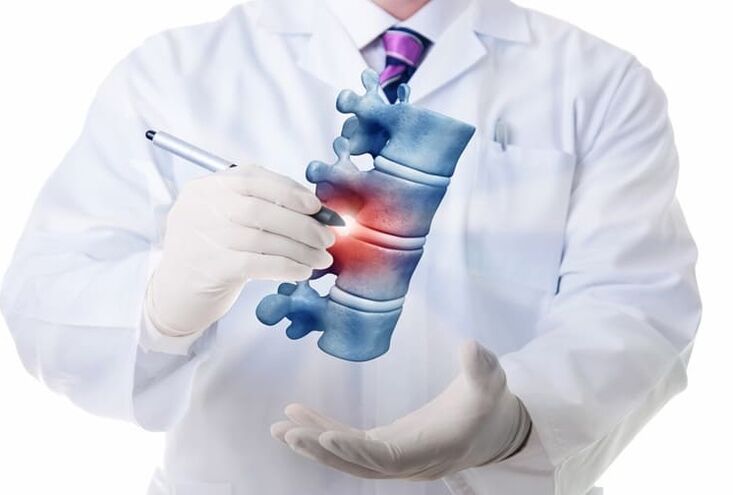
Osteochondrosis of the thoracic spine does not manifest itself as often as osteochondrosis in other departments, but it is just as tapered as other types of this disease. To date, it is diagnosed in as early as 20-year-old adolescents, which is related to both lifestyle and diet.
Thoracic osteochondrosis is the least common form of pathology, but the most dangerous of all types of osteochondrosis. The symptoms of thoracic osteochondrosis are so atypical that they can be attributed to other diseases such as a heart attack or angina pectoris.
The disease really poses a threat, because without proper treatment, osteochondrosis over time can provoke a malfunction of the heart, and the boundary between these states is very narrow.
Symptoms of osteochondrosis
The thoracic spine is less mobile due to its anatomical features. As a result, there is less load on it, and therefore osteochondrosis occurs here much less often. When the first pathological changes appear in the chest area, patients do not feel any signs of the disease for a long time, since it develops slowly.
The symptoms of osteochondrosis depend on the stage of development of the disease and are fully correlated with it. At an early stage, the symptoms are less pronounced, while late osteochondrosis provokes serious signs, for example, a feeling of pain in the heart, an increased heart rate. The manifestations of the disease are as follows:
- in the first degree of development of the disease, complaints of osteochondrosis appear due to a violation of the integrity of the intervertebral disc. The fracture can be provoked by a sharp clumsy movement or a large load in the region of the thoracic vertebrae. At these moments, patients experience increased sensitivity in this area of the spine, experience severe pain and muscle tension. Patients note that the sensations are comparable to an electrical discharge passed through the back;
- The second degree of the disease is characterized by bulging of the intervertebral discs, protruding to a distance of 5 mm. The spine becomes unstable, the diagnosis requires a thorough analysis of the patient's health, since patients constantly complain of discomfort and pain behind the chest, muscle tension, which can be a symptom of various pathologies;
- the third degree of thoracic osteochondrosis has more significant manifestations - pain becomes more frequent, patients experience breathing problems (sudden shortness of breath, feeling of lack of air), feel a headache, and there are disruptions in the heart with osteochondrosis.
Important!The fourth stage of the disease is the most dangerous for the patient. Here osteophytes appear on the surface of the vertebrae, compressing the spinal cord and nerve endings.
At different stages of the disease, patients are haunted by the following pathological symptoms:
- Intercostal neuralgia - a feeling of severe pain in the sternum. Initially, the pain can appear only in one place, but after a while the pain completely covers the human chest. It becomes difficult for patients to breathe, change the position of the body. When you try to bend down, move or stand up from one place, the painful sensations increase significantly;
- muscle spasms - pain in the muscles of the back is quite strong, and the pain spreads to the lumbar region and can even radiate to the abdomen and shoulders. Cramps are reflexive in nature; H. they themselves do not respond to pain, but to spastic contractions of other muscles;
- a pre-occurring malaise - it can vary in strength and manifest itself long before the exacerbation. Unpleasant sensations haunt patients for several days or even several weeks before the appearance of more serious signs of osteochondrosis. Usually, discomfort is only in the back and sternum and may either go away or worsen;
- With osteochondrosis, the symptoms of the pathology are usually more pronounced at night. In the morning, the patient feels content, although in the cold season or with sudden movements, osteochondrosis reappears.
Atypical symptoms
Chondrosis is insidious in that its symptoms may not resemble back pain at all. And sometimes the patient does not even suspect that the problem of the discomfort lies precisely in the spine - he takes painkillers or heart medication that have absolutely nothing to do with the cause of the pain.

If there are several symptoms, you need to contact the clinic for professional advice from a doctor - only after a comprehensive examination can osteochondrosis or heart disease be detected
To suspect osteochondrosis, you need to know what manifestations can indicate the disease:
- the appearance of pain in the heart area, more similar to the symptoms of angina or even myocardial infarction. Such colic can last for weeks, and the drugs used to dilate the coronary vessels do not have a positive effect on the situation at all;
- exacerbation of the disease can provoke pain in the mammary glands and a tightening in women, as during pregnancy. Therefore, when such sensations appear, it is necessary to consult a mammologist.
- spastic pain in the upper abdomen, which some patients consider to be symptoms of gastritis, cholecystitis or pancreatitis. The pain usually gets worse with increased physical activity. Such signs of pathology can seriously impair the functioning of the gastrointestinal tract;
- problems with the functioning of the bladder and genitals;
- Pain in the throat and esophagus, foreign body sensation and pain when swallowing.
With osteochondrosis of the thoracic spine, Dorsago syndrome is manifested, which is characterized by the appearance of very severe pain in the sternum, which occurs when rising from certain positions - sitting or lying down. Unpleasant sensations behind the sternum are so strong that it becomes difficult for patients to breathe, there is muscle stiffness, pain when turning the neck in the lower back.
Dorsalgia develops slowly. At the initial stage, discomfort occurs only with active movements, and after a while it can be felt constantly. At the peak of the disease, even a deep breath can produce painful dorsal pain.
signs of heart pain
Patients often confuse heart pain with manifestations of osteochondrosis, and this is not surprising, because with vertebral diseases, the discomfort in the sternum is so strong that under a feeling of anxiety, patients suspect the worst - heart problems. To distinguish heart pain from osteochondrosis, you need to know the main signs of heart pain:
- Localization - the correct definition of localization makes it possible to partially eliminate doubts about chondrosis. Heart pain usually occurs well behind the breastbone or is localized in the left half of the breastbone. It radiates between the shoulder blades, can reach the lower jaw, can be felt in the left hand;
- characteristic of pain - pain in the heart is distinguished by enviable persistence, it is compressive, pressing in nature, cheeks behind the sternum and due to the sharp nature of its occurrence, such pains were called "dagger";
- provoking factors - usually pain in the heart has a clear factor, under the influence of which the pressure increases and discomfort appears. It can be both physical activity and a factor of emotional distress and stress. At rest, when a person is relaxed and not nervous, there is usually no pain in the heart region, but even with a minimal load that causes narrowing of the vessel, angina develops;
- the time factor - heartbreak doesn't last long, you can always set its beginning and end. As a rule, an attack of angina pectoris is embedded in a few minutes. The heart does not prick in advance, does not hurt and does not pull. Usually it is the time of previous complaints that makes it possible to distinguish osteochondrosis from real heart pain, the duration of one attack of which is mainly limited to 15-20 minutes;
- The manner of cessation of chest pain is an important factor that doctors also consider when distinguishing osteochondrosis from heart disease. Usually, a heart attack is pumped quickly, while the patient needs to stop the provoking factor - stop exercising or calm down from stress. You can take a nitroglycerin tablet, which in most cases helps to eliminate discomfort and even completely stop the pain within a few minutes. With a myocardial infarction, nitroglycerin does not cope with the pain, and patients need emergency help.
Advisory!These characteristics are typical of heart pain, but angina pectoris can also cause shortness of breath, leading to stomach pain. Therefore, the symptoms that have arisen must be analyzed in a complex, taking into account the relationship and focusing on cardiac manifestations.
Problems with the diagnosis of cardiac pathologies can not always be solved by patients who do not have at least a general idea of how real pain in the heart is manifested and what complaints with osteochondrosis look like, therefore, in a critical situation, doctors advise not to delay the manifestations of the pathology andalways call an ambulance for help".
Osteochondrosis as a cause of cardiac pain
Pain behind the sternum can be a manifestation of pure osteochondrosis, real pain in the heart, but do not lose sight of what osteochondrosis affects the heart in and of itself. Doctors have long talked about the connection of this disease with heart pain, but now there are scientific studies confirming the mechanism of occurrence of heart pain, the etiology of which are problems of the musculoskeletal system, namely osteochondrosis of the chest area.
There are nerve connections between the spine and the heart, which impair the work of the heart and cause malfunctions in the organ. The stellate ganglion takes an active part in the innervation of the heart, from which the vertebral nerve departs - part of the sympathetic plexus of the artery of the spine.
The sympathetic plexus indirectly affects the brainstem and cortex. Therefore, in osteochondrosis, nerve connections can provoke a variety of heart pain syndromes, metabolic consequences that affect the contractility of the heart muscle, and the occurrence of arrhythmias.

Few people know that both diseases develop already by the age of 40-50, and late diagnosis leads to combined symptoms, which leads to errors.
Difficulties in diagnosis are that patients suffering from osteochondrosis acquire the disease over the age of forty-fifties, and already at this age the first heart diseases appear. Therefore, the diagnosis of osteochondrosis and coronary artery disease leads to frequent mistakes - it is difficult to determine the etiology of pain. This happens for the following reasons:
- insufficient diagnosis of the cause of heart pain;
- limited knowledge of cardiologists about whether the heart can hurt with osteochondrosis;
- reassessment of the results of the ECG, after which the patient is almost immediately marked with one or another diagnosis;
- the absence of an X-ray showing a pronounced sign of osteochondrosis of the thoracic spine.
Also, the type of projection pain, its localization and the patient's sensations are not always taken into account in the diagnosis. Therefore, such flaws in the diagnosis lead to the fact that about 80% of patients with osteochondrosis receive an incorrect diagnosis at the initial examination - coronary artery disease. Even an ECG with a high T wave confirms this diagnosis, but doctors prefer the first factor, not understanding whether it is the heart or osteochondrosis.
Only additional examination and x-rays can determine that the pain in the heart with osteochondrosis is neurodystrophic, and not ischemic in nature. It was she who affected cardialgia, provoking characteristic manifestations and, as a result, diagnostic errors. Also, studies note that pain in the heart most often occurs in patients who already have pathologies of the organ, in particular, atherosclerotic changes in the vessels.
Important!The main threat in the diagnosis of such pain is the ratio of the coronary and non-coronary components as the cause of the discomfort behind the sternum. This facet, which is the effect of osteochondrosis on the heart, is extremely difficult to single out.
There have been studies that followed a patient with coronary artery disease, a severe angiotic condition, who did not develop a myocardial infarction within a week of cardiospasm, although the ECG data were quite ominous. However, the degree of severity spoke more for the non-coronary component.
The main task of the doctor in this case is to correctly diagnose the disease, assess the patient's state of health, especially the indicators of the work of the heart, and predict possible threats to the patient's life, since with a linked genesis - coronary and non-coronary -it is extremely difficult to filter out the respective part. According to statistics, in one hundred percent of cases patients come to the clinic for urgent treatment precisely with a diagnosis of a pre-infarction condition or myocardial infarction.
elimination of pain
After clarifying the causes and making the diagnosis, the doctor will prescribe treatment - a detailed treatment regimen will help the patient control pain and prevent the development of complications. Therapy includes drugs, physiotherapeutic treatment methods, homeopathy. The most important therapy methods are:
- Bed rest is recommended until pain has completely subsided;
- to eliminate heart pain, it is necessary to take analgesics, antispasmodics, patients are recommended steroids or nonsteroidal anti-inflammatory drugs if osteochondrosis is detected, but they should not be abused due to their adverse effects on the gastrointestinal tract;
- In addition to drugs for oral use, you can use various anesthetic creams, gels and oils. Effective remedies with safe components are medicines based on bee venom, turpentine, tea tree oil;
- to activate blood circulation, nootropics, chondroprotectors, vasodilators and diuretics are useful.
- An excellent effect on the body of a sick person will be conducting a course of physiotherapy. The prescribed methods will help both to cope with the manifestations of osteochondrosis, and to strengthen the body with heart pain;
- Acupressure in the spine with a special focus on damaged tissue helps manage back pain and muscle stiffness. All areas subject to spasms are relaxed, pain is eliminated. At the same time, acupressure helps to correct posture;
- In the subacute period, physiotherapeutic exercises aimed at strengthening the muscles in the projection on the thoracic spine are allowed. You can visit the pool, do special fitness training;
- A diet helps to get rid of pain - the doctor separately recommends products for the pathology of the musculoskeletal system, correcting the nutrition of the nuclei, enriching them with substances necessary for the normal functioning of the heart muscle. Traditionally, in all patients you need to take care of the use of fatty, sweet and salty, if necessary, you need to reduce excess weight.
The most important
Osteochondrosis of the thoracic spine refers to degenerative-dystrophic lesions of the cartilage tissue, as a result of which a person experiences severe pain and discomfort. The disease develops mainly in patients over forty years old, its appearance is influenced by joint pathologies, traumatic injuries, hereditary factors, stress, metabolic disorders, imperfect working conditions, hormonal disorders. Osteochondrosis itself can cause heart-like pains, and also indirectly affect the development of cardiac pathology.
To differentiate the pathology, a special diagnostic test is performed - novocaine blockade of the stellate node, which helps to find out the patient's diagnosis and correctly assess his condition. In addition, it is worth considering the irradiation of pain, the effectiveness or ineffectiveness of cardio drugs, the presence of changes in the ECG made at different times.
Treatment is prescribed depending on the cause of the disease, which can be identified after a thorough examination. Cardiac drugs are recommended to treat coronary artery disease, while osteochondrosis can be cured with NSAIDs, steroidal anti-inflammatory drugs, and chondroprotectors, and in some cases surgery is required.






























